
Why did my mature conifer (cone bearing) or deciduous (trees that lose their leaves in the fall) trees suddenly die? Arborists often get asked this question by grieving tree owners. This question deserves a serious answer, since an unbreakable bond exists between humans and trees, and when that link is unexpectedly broken, there are negative consequences for humans and the environment. This is because trees have such a large impact on our lives and often impact all types of human activities. Moreover, whether we are consciously aware of it or not, our lives are intertwined with trees, and even depend upon them for our survival, and when we lose them there are economic, social and cultural, emotional and environmental consequences. If we understand why trees die, maybe we can proactively help to keep them alive.
So why do trees die? And if we understand the reasons why they die, perhaps through wise and knowledgeable actions on our part, we can help to keep the trees in our lives alive longer. After all, as caretakers of this planet, it is our responsibility to care for the small piece of real estate over which we’ve been given stewardship including the trees on it. Face it, the simple fact is that without trees, all animal and human life will die!
With these things in mind, many years ago, as a tree care professional—in the industry, we’re called arborists—I felt that I was taking out too many trees that I knew were savable. Therefore, I rolled up my sleeves and got the necessary education, credentials, licenses and then purchased the equipment to begin providing plant health care services in my tree care company. Since then, I have saved hundreds, if not thousands of trees from their demise. This has been a rewarding activity for me on many levels.
But along the way, I have found that there is a belief among many of my clients that all trees have a life span and eventually grow old and die. For many people, this seems to explain why their yard tree suddenly died. Yet, in my decades as an arborist, I have found this belief usually to be unfounded. Since there are so many variable factors that contribute to tree mortality, it’s often not easy to determine why a tree has died without conducting extensive and costly forensics. Suffice it to say, many of the factors listed below combine to stress a tree, and if the tree doesn’t possess a sufficient reserve of stored energy to combat its stressors, it will eventually succumb to these stressors. Almost everything that a tree does is in slow motion. It grows slowly, its metabolic processes occur slowly and it usually dies slowly as well. On occasion, a tree dies quickly (in a few weeks or months), but this is rare. Like the rest of us, a tree has a strong survival instinct and wants to live. In fact, it contains many built in mechanisms to insure that it survives come what may. So to say that a tree has a certain life span and then it just dies is a misnomer. True, some trees are able to live for hundreds, even thousands of years, while other trees are relatively short lived, by comparison. But under the right conditions and with the right care, nearly any tree you plant in your yard can outlive you and probably your grandchildren too.
The Reasons Trees Die
So now let’s discuss why trees. The following is a list of some of the more common reasons of tree mortality.
Drought. Like humans and all animal life, plants need water to survive. No water, no life. Trees suck up an immense amount of water out of the soil on a continual basis, especially during the growing season. If they don’t obtain the water they need, the go into stress mode. If this continues long enough, they will slowly die of thirst.
Too much water. Yes that’s right. You read that right. Every species of tree prefers a certain amount of water. A tree that is at home in a swamp will not survive in an arid region and vice versa. When planting trees, it’s vital to match the tree to the climate and water conditions to which it is accustomed in its native environment. This is common sense. Yet often we love our trees so much that we over-watering them, or we plant them in places that are too wet, and they die from “wet feet” or fungal rots and anaerobic conditions.

Constructions trauma. Humans are constantly changing their environment, and trees are often in the way. Many times we remove them to construct a building, road, a parking lot or to dig a trench. When possible, times, we leave the trees, but if we don’t protect them during construction activity, they can be negatively affected. I have seen large trees caught in constructions areas die within a few months, and I have seen other trees take year, if not decades to die due to construction stress. Here’s a list of construction activities that can weaken or even kill a tree.
- Soil compaction due to heavy equipment driving over the trees’ root zone. The major root zone of a tree will extend not only to the drip line of its canopy, but can extend two or three times beyond that.
- Tree roots cut due to excavation activities.
- Soil added or subtracted from root zone.
- Change of grade so that trees receive less or more water than it was accustomed to.
- Construction equipment hitting up against trees and damaging them.
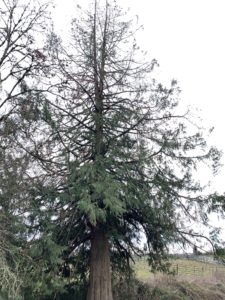
Soil born fungi. More goes on under the soil when it comes to tree health than we realize. Sometimes it’s a virtual war zone underground with the good guys and bad guys fighting it out for food and space to grow in. Some soil born fungal pathogens prey on weak trees vampirizing sugars from the vascular system in the tree’s roots and trunk. This can lead to root and trunk rots, which can slowly kill a tree. Often when you see a tree that is dying in its upper crown, this is a symptom of pathogenic fungal activity in its roots, which can result in the death of the tree.
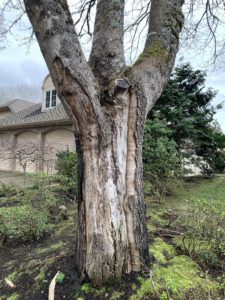
Climate change. The climate has been continually occurring as long as there has been plant life. We know very little about what causes it and the factors that influence it and how they all interact. This we know. Trees have been adapting to climate change forever. Ice ages, tropical rain forests, jungles, arboreal forests, floods, volcanic activity have come and gone, and trees have been marching back and forth across the landscape for eons of time adjusting to variations in climate and all of the things that influence it. In some areas, the climate is getting cooler, and in others it’s getting warmer. Who knows how long these cycles will last? Scientists have only been measuring these variations for a few years, so our perspective and understanding is limited in scope. The problem is that trees need a stable environment. Major climatic changes over a long enough time cause them stress, and eventually death. New species will come in that are better suited and the old species move to new areas replacing other tree species in those areas. This is the cycle of life. Humans do the same thing. This is the ebb and flow of a all living organism on planet earth. This has been going on for thousands, maybe millions of years. So when our favorite trees dies because of climate change, it affects us negatively. When a whole forest dies, this can be cataclysmic. However, over time, new species of trees will come in and take over. This is how things work. Can man really do anything about it? Likely not. Humans can’t control solar flairs and volcanos, and science hasn’t conclusively proven that we can control the ocean temperatures or atmospheric conditions to any great degree. Anyone who says we can likely has a political agenda that they’re peddling to the unsuspecting sheeple for their own monetary and ideological advantage. Meanwhile trees just keep on doing what they’ve been doing forever long before man was here. The cycles of life and death just continue to go on with or without humans.
Seasonal weather stress. Trees like a stable environment. When things don’t go right, they can’t just get up and move to a new location. Moreover, tree exist in the slow, the very, very slow lane of life. They grow slowly, they move water and nutrients slowly through their vascular system and they react slowly to predators and to weather fluctuations, and they adapt slowly to a changing environment. Slow changes in weather patterns and in seasons allows a tree to gradually adapt. When sudden changes in weather occur such as sudden temperature swings, unexpected heat or frosts or desiccating winds, this puts stress on the tree, which is sometimes too much for the tree to handle and the tree may die.
Soil compaction. Trees often get in the way of human activity. We park our cars under them. We put picnic tables and playgrounds under them as well as parks and campgrounds. How many times have you seen build livestock barns around trees, only to see them die as the cows and horse trample the soil under the trees? Trees like to grow in loose, aerified soil, so that water and nutrients can freely move and micro-organisms can live. When the soil goes from being like a sponge to a brick due to soil compaction, this can kill a tree.
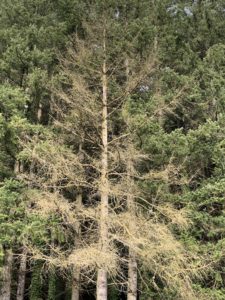
Overcrowding of trees. When too many trees live in too small of an area, they end up competing with each other for a limited amount of soil moisture and nutrients. This can result in the death of the weakest trees due to stress caused from starvation. This is called the survival of the fittest. This can explain why one tree will suddenly die in the midsts of numerous other trees including those of the same species.
Lack of sunlight. Trees can’t grow without sunlight. When a tree finds itself in a dense forest, it reaches for the light. If other trees outgrow it, the runt tree will slowly starve to death. If trees can’t get sunlight, they can’t produce food through photosynthesis. Without food, like every other living organism, a tree will die.

Insects. Insects are usually not the primary cause of tree mortality. In a majority of cases, insects invade a tree once it is already stressed or weakened due to other factors. As part of the cycle of nature where every living thing eventually dies and returns to the earth, insects are a necessary part of aiding that natural process. However, there are a few insects that by themselves will bring about the death of a tree. But, again, usually, the tree was already beginning to show signs of stress in the first place, thus signaling to the insects to come and feast on it.
Viral and bacterial pathogens. When a tree is wounded or stressed, on occasion, viruses and bacteria can enter a tree and weaken it, and on occasion, even kill it. In our area, this is uncommon, so we won’t discuss it now.
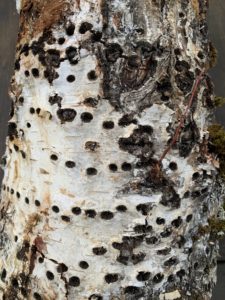
Sapsucker woodpeckers. Many species of trees in our areas show signs of sapsucker activity up and down their trunks. These are uniform holes smaller than a pencil eraser that are pecked through the bark down to the cambial layer. Sapsuckers suck up the nutritional tree sugars that are the lifeblood of the tree. Maple syrup is made from this same substance. Most larger trees can survive sapsucker activity. However, if small trees are riddled with holes around the circumference of the trunk, this can cause the decline and ultimate death of a tree. I have seen this, for example, occur in small, juvenile birch trees that are two or three inches in diameter. I have never seen a large tree die due to sapsucker activity.

Over-pruning. Yes, a tree can be killed by removing to much of a tree’s crown through pruning. I have seen this happen, and I did it once years ago. I learned from my mistake, and it has never happened again! Yes, we can remove a certain amount of foliage from a tree without hurting it, but this depends upon the species of trees, the health of the tree, the climate and the time of the year. A qualified arborist will understand these variables and will not kill your tree through over-pruning!
Lack of soil nutrients/fertilizer. Trees can slowly starve to death due to lack of soil nutrients and fertilizer. Without these, trees can’t produce food. When deprived of vital soil nutrients, a tree can draw from its own stored reserves, but eventually, these will run out and a tree may continue to languish for many years and then eventually die.
Planting the wrong tree in the wrong place. This is an often overlooked and under reported reason for tree mortality. All trees are native to some spot on earth. In that region where they originally came from, the climate, elevation, soil conditions, biota or web of life are optimal for that tree to grow and remain healthy for many years.
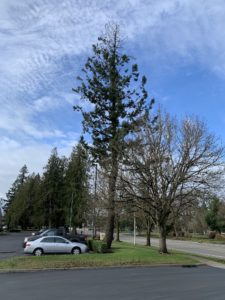
The problem arises when we take that tree from its native environment and force it to grow it in a less than favorable area. The fact is that as adaptable as trees are, they have limits to their adaptability. A tree that needs copious amounts of water won’t survive long in a desert. A tropical tree refuses to live in a northern climate. A tree that is naturally suited to well-drained soils will not grow in soils that tend to retain water.
Few if any large trees do well when forced to grow in limited areas such as in planters and narrow planting strips between roads and sidewalks. Their roots simply don’t have enough soil volume in which to grow and gather the water and nutrients they need for longterm survival. Because we often plant trees in the wrong places, they often die.
What to Do If Your Tree Is Dying
There is no silver bullet or cure-all when it comes to dealing with stressed or dying trees. Like a medical doctor with a sick patient, one has to become an inquisitive and discerning investigator. Questions have to be asked, the patient evaluated, the tree’s environment studied and tests conducted. This is process is called diagnostics. Then all of these factors have to be analyzed and then conclusions must be drawn. After this, a prognosis is made and possible treatment plan is formulated. As in the medical field, so it is in the field of botany and tree care. Diagnosing plant problems and then recommending cures involves science as well as a lot of field experience. Some tree ailments are easily diagnosed, others are more difficult to ascertain, especially when there are multiple factors contributing to the tree’s physical decline.
So, if you’re beloved tree suddenly seems to be slipping toward an early grave, there are several thing you can consider doing.
- Get help from a professional arborist. Call an ISA Certified Arborist who can diagnose your plant problem and prescribe a treatment program. Remember this one thing. In most cases, removing and replacing a tree is much more expensive than preserving an existing tree. Plus, with the loss of a mature tree, one loses all the economic, cultural and environmental benefits large trees give us—something that smaller replacement trees cannot do. So proactive plant health care is a wise use of your finances and even an investment in the future for a variety of reason, which we have discussed elsewhere in more detail.
- Add mulch. Mulch your tree with three to six inches of wood chips or something similar. This not only helps the soil to retain moisture, where it will accessible for tree roots to uptake, but it keep the soil cooler in hot weather (a more conducive environment for healthy root growth). Mulch also prevents competitive vegetation from growing under the tree, and it adds vital nutrients to the soil under the tree. Your typical barkdust mulch doesn’t feed the soil. Wood chips do, however.
- Fertilize. How about fertilizing stressed trees? Depending on the situation, this may or may not be the right thing to do. If your tree is drought stressed, only slow release fertilizers with proper watering should be done, otherwise harm can be done to the tree. For trees that are stressed due to other factors, a quick release fertilizer is almost never a good prescription, since it may stimulate the tree to use valuable energy reserves to support the growth of new foliage that should be used for fighting pest attacks. Only slow release fertilizers should be used. Talk to your ISA Certified Arborist about this.
- Water. Make sure your tree has the right amount of water, especially warm weather or drought conditions. The typical lawn irrigation system doesn’t provide a tree with enough water to reach its roots that are 12 to 18 inches deep, thus extra water is needed to reach the deeper tree roots.
- Clear the space in the tree’s root zone. Reduce competing vegetation around the root zone of the tree by removing grass, ground covers and weeds that are stealing vital nutrients from your the tree. Remember this. Shrubs, ground covers, grass and weeds come and go; they’re short-lived plants compared to a tree that may live for hundreds of years. When it comes to establishing priorities in your landscape, give your trees the right-of-way over your other plants. The benefits that trees provide the planet far outweigh those of smaller shrubs, weeds and grass. If you have a lot of trees, consider thinning your forest. This involves removing some of the smaller, unhealthy understory trees or less desirable larger trees that are taking resources away from the larger and more healthy trees that you want to keep. Nature thins and culls its forests naturally through forest fires, drought, disease and insects. It’s called the survival of the fittest, and this process naturally allows for the strongest and best specimens to survive by culling out the weaker and less desirable one.
- Deal with soil compaction. Reduce or eliminate soil compaction under the tree from vehicular and foot traffic. The soil in which a tree’s roots grow is its source of life. Healthy soil means a healthy tree, therefore, it’s vital for your tree’s health to protect the soil in the rootzone of the tree. The rootzone of a tree can extend well beyond the tree’s drip zone. If the soil in the root zone is trampled to death, this can compact the soil to the point that the tree’s roots can’t grow properly. Consider adding three to six inches of mulch over the top the tree’s root zone. This goes a long way to reducing soil compaction in high traffic areas thus reducing soil compaction.
Conclusion
Books have been written and PhDs have been earned on each of the points listed above on the causes of tree mortality and ways to prevent a tree from dying. What I have written is merely the tip of the tip of the proverbial iceberg, but hopefully it will bring to your level of awareness some of the factors that determine the viability and longevity of the trees in your life, and what you can do to steward the small piece of this earth that has been loaned to you for your good stewardship.
